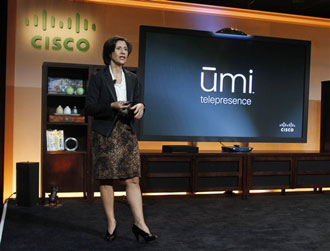Cisco to Sell HD Home Video-Conferencing Box
By wchung | 02 Dec, 2025
Cisco Systems Inc., seeking to become a bigger name in consumer electronics, said Wednesday that it’s going to start selling a $599 box that turns living-room TV sets into big videophones.
It’s the first entry by Cisco, the world’s largest maker of computer-networking gear, into a home videoconferencing market that’s been dominated by free, PC-oriented services such as Skype SA.
Cisco said that the “umi” device, pronounced “you me,” will include a camera and a TV set-top box and will be controlled by a remote. It will give consumers such features as the ability to retrieve video messages left for them when they’re not at home.
The service requires users to have a fast Internet connection and a high-definition TV set and will cost $25 per month on top of the purchase price.
Cisco emphasizes that the system will produce high-definition, lifelike video, but the quality will also depend on the speed of the home’s broadband connection.
For high-definition video, the umi needs an Internet connection that can send, or upload, data at 1.5 megabits per second, higher than that of typical DSL or cable services. At lower speeds, the umi falls back to standard definition, which is already available for free with Skype.
For the very best “1080p” resolution, umi needs a 3.5 megabit per second upload, available only with the most expensive cable modem packages or Verizon Communications Inc.‘s FiOS fiber-optic service.
In a demonstration to reporters, a video call over umi started out with some choppy audio, which was attributed to adjustments made by the system to account for ambient noise. In general, the video looked flawless and sound quality was good. The system has a zoom feature built into the remote, so you can show, say, a close-up of your child’s artwork to a family member on the other end.
Umi may prove to be a boon for cable TV companies and Verizon. So far, there haven’t been many applications that benefit from the high upstream speeds that come with their top-tier services.
Competing consumer-level videoconferencing services mostly don’t produce high-definition video, but TV manufacturers have already started to bring video calling into the living room. New TVs this year from Panasonic Corp. and Samsung Electronics Co. can use the Skype conferencing service with accessory cameras.
Cisco, which is based in San Jose, Calif., said the umi will be sold at Best Buy and Magnolia Home Theater stores starting Nov. 14. Verizon also said it will sell the system starting next year to customers who have FiOS.
Despite umi’s price and other requirements, the company seems confident that there is a market for the product. Citing data from market research firm IDC, the company says more than 32 million households already have high-speed broadband service and high-definition televisions. That figure is expected to rise to more than 60 million households by 2012.
Gina Clark, vice president and general manager of Cisco’s consumer Telepresence unit, said the price tag will be palatable to plenty of consumers, as it gives a much more immersive experience than chatting on a computer with a webcam.
“It’s clearly an experience that brings people together in a way that no other product will,” she said. “It’s obviously got a premium price tag as well.”
She said Cisco believes there will be a rapid switch to higher-end videoconferencing, just as consumers rapidly migrated from standard-definition to high-definition television sets over the past few years.
Cisco has been selling corporate videoconferencing equipment for years, focusing on the very highest end of the market – so-called “telepresence” systems that take up a whole room, with large plasma screens and carefully staged lighting.
Earlier this year, it broadened its portfolio considerably with the $3.4 billion acquisition of Tandberg ASA, a Norwegian company that made systems ranging from telepresence setups to videophones on the desk.
In the consumer videoconferencing space, Cisco is competing not just with Skype and TV makers, but with Logitech International SA of Switzerland, a big maker of webcams. On Wednesday, Logitech revealed its $299 “Google TV” Internet set-top box, for which there will be an optional camera for high-definition videoconferencing.
At the same time that it’s becoming a competitor, Cisco also sees itself as something of a partner. Umi will work with Google’s Video Chat, allowing users to talk with friends who are using that program on a computer. And while umi doesn’t currently integrate with Skype, Cisco said it is open to the possibility.
Cisco shares rose 31 cents, or 1.4 percent, to close Wednesday at $22.30.
RACHEL METZ, AP Technology Writer SAN FRANCISCO

In this photograph taken by AP Images for Cisco, Gina Clark, Vice President and General Manager, Consumer Business at Cisco introduces Cisco umi, Wednesday, Oct. 6, 2010 in San Francisco. Cisco umi is a first of its kind consumer product that brings family and friends together in HD video, whether they are around the corner or across the country. (George Nikitin/ AP Images for Cisco)
Asian American Success Stories
- The 130 Most Inspiring Asian Americans of All Time
- 12 Most Brilliant Asian Americans
- Greatest Asian American War Heroes
- Asian American Digital Pioneers
- New Asian American Imagemakers
- Asian American Innovators
- The 20 Most Inspiring Asian Sports Stars
- 5 Most Daring Asian Americans
- Surprising Superstars
- TV’s Hottest Asians
- 100 Greatest Asian American Entrepreneurs
- Asian American Wonder Women
- Greatest Asian American Rags-to-Riches Stories
- Notable Asian American Professionals

